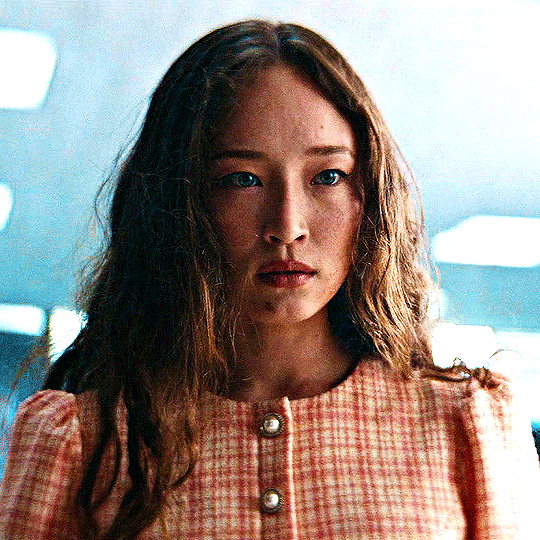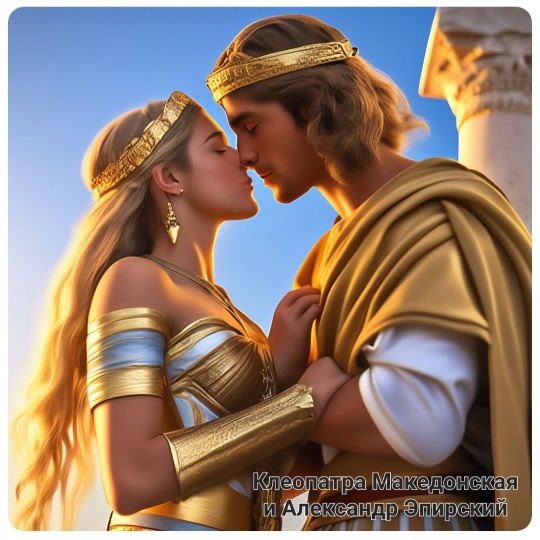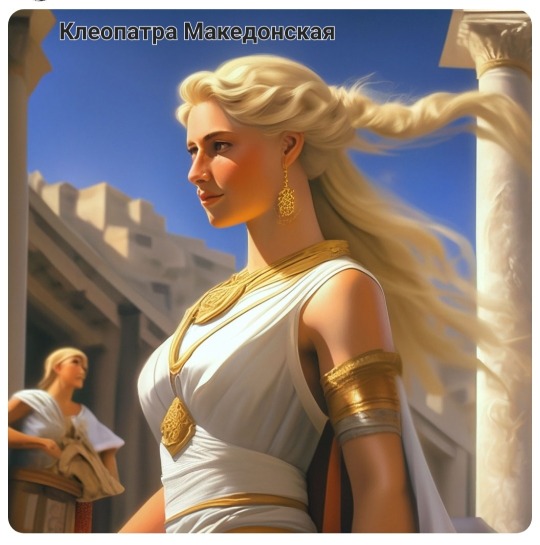#Cleopatra of Macedon
Text
“Alexander the Great had three sisters - Cynnane, Cleopatra, and Thessalonice - and all three were eventually murdered. Since both' of Alexander's sons met similarly violent ends, it may appear at first glance that little distinguishes the pathetic life and death of each of these three royal sisters from the more pathetic and yet shorter lives of their nephews. Indeed, even earlier in the century, before the long and troubled demise of the Argead house had begun, very few male Argeads managed to die at home in bed.
On reflection, however, the very fact that a long dynasty was coming to an end should have meant that the sisters of the last king would have a better chance of survival than the minor male heirs of that king. After all, once the father is dead, the heirs are for practical purposes (assuming they are well below the age of maturity) no man's sons, and can do no would-be dynast any more than short-term good, whereas the king's sisters can be married and thus legitimize the seizure of royal or quasi-royal power. Better yet, a king's sister may produce children of the blood of the old royal house, as well as the new.
But two of Alexander's sisters did not realize the potential advantage seemingly inherent in their situation and ultimately all three died exactly because they were Philip II's daughters and Alexander's sisters. This failure to realize the potential to be the bridge between two dynasties is most surprising in the case of Alexander's full sister, Cleopatra. Analysis of the careers of Alexander's relatively obscure sisters, worthwhile as an end, in itself, should answer the question of why the Successors proved to prefer murder to marriage (in two of the cases) as well as produce important information about the nature of Macedonian monarchy in a period of great and rapid change. The significance of the similarity in ultimate fate of the three sisters and their nephews has been ignored for too long.
“... Calling Alexander's sisters his "relicts" is meant to convey two truths about them: their similarity to the other relics of Alexander (his corpse, his tent, and, of course, his empire) and their manipulation by various of the Successors and (by means of allusion to the older meaning of "relict" as a female survivor of some related and now departed male, with its implication of the lack of a separate existence for such women) their peculiarly property-like quality in the period after the death of Alexander. The answer to the question posed initially - why did Alexander's sisters fare so poorly and so similarly to their nephews - should now be clear. Alexander had no successor. Even Antigonus, although interested in the same land area as Alexander, was not a true successor to the curious monarchy Alexander had invented - a traditional national monarchy onto which a curious sort of personal monarchy had been grafted - Antigonus was, like the other generals, on the way to creating a personal monarchy. Thus even he did not really need Cleopatra. Cassander, with his marriage to Thessalonice and at least superficial attempt to imitate the traditions of Macedonian monarchy, could not really be Philip's heir because he could not be an Argead; he had murdered Argeads and would probably have liked to murder more. Until the death of Alexander, Macedonian kingship had been tied to one dynasty. This was so much the case that the kings used no title, but simply signed themselves as so and so, son of an Argead. Trying to decide whether Philip's or Alexander's reputation was greater after 323 is ultimately devoid of any real political meaning; neither had any real successors and thus Alexander's sisters and Philip's daughters, representing as they necessarily did continuity with what had come before, could have no future.
Cynnane died in an ill-advised attempt to take royal power by military and quasi-military means; the army did not save her. Thessalonice died in the death throes of the pseudo-dynasty Cassander had fabricated, her death demonstrating that even her son did not need to see himself as the heir to the Argeads. Cleopatra died making one last attempt to function as a symbol of continuity, and for that she was murdered. The sisters were expendable because continuity was neither needed nor genuinely desired.”
Elizabeth Carney, “The Sisters of Alexander the Great: Royal Relicts”
*I disagree that Cynnane's attempt to take royal power was ill-advised. As Carney herself points out in another book, "although this daring plan ultimately proved fatal for Cynnane, it succeeded in its object and was brilliantly conceived".
#the visceral tragedy of thessalonike's life always gets me#historicwomendaily#history#cynnane#cleopatra of macedon#thessalonike#thessalonike of macedon#alexander the great#macedonian history#ancient greece#ancient history#queue
28 notes
·
View notes
Note
Is it true that Alexander was against is baby sister Europa being killed? Or did he not know/have an opinion about it?
We don’t know when Olympias killed Kleopatra and baby Europa. Probably sooner rather than later; that is, on Alexander’s initial trip to south Greece, after he took the throne. By all accounts (and there aren’t many) he wasn’t in Pella when it happened. Plutarch tells us he was furious upon his return. He probably was, but not just because of the cruelty.
Tim Howe has an interesting theory in “Cleopatra-Eurydike, Olympias and a ‘Weak’ Alexander,” which suggests he’d intended to marry Kleopatra himself. This wouldn’t be the first example of a Macedonian king marrying the young widow of the prior king. Same thing happened with Archelaos who married the widow of his father Perdikkas II. (Ironically, she was also a Kleopatra.) Archelaos then killed his (unnamed) seven-year-old rival half-brother by Kleopatra. Although we can’t be 100% certain it’s the same woman, the likelihood is very high. We don’t know if the marriage occurred before or after he killed the boy. He then had a child himself by Kleopatra (which child, in turn, was murdered after Archelaos’s death and never took the throne).
Welcome to Macedonian politics.
In Alexander’s case, he wouldn’t have needed to kill the infant girl, as she was no threat. But by marrying his father’s widow, he could actively ‘perform’ his announced, “Only the name of the king has changed,” and secure political alliances before marching for Persia.
Yet a potential marriage on the horizon would be a very good explanation for Olympias’s action. On the face of it, the murder seems unduly vicious. An infant girl was, again, no threat—nor was Kleopatra herself. Perhaps Olympias did it purely for retribution, but she rarely acted for “mean” reasons. Killing Kleopatra suggests she was somehow still a threat. Why? Her uncle, Attalos, couldn’t be king (not an Argead), and her child was female. Why kill the widow?
Unless Alexander intended to marry her. What Alexander may have seen as good policy for him was a serious threat to Olympias’s own status. So she eliminated that option.
That would also explain Alexander’s apparent fury. Yes, he probably was horrified by the murder of an infant, but children under a year old already occupied liminal status, waiting to see whether they’d survive to their first birthday. I don’t mean that to be dismissive, but Europa’s life, or death, didn’t impact him much, politically. He may have seen her only a handful of times, so she was probably “nebulous” to him, his emotional reaction generic rather than specific.
His mother being responsible for the death of his father’s widow, however, DID impact him politically, upending any decision to marry her, plus requiring him to eliminate Attalos, who now had a blood feud with him. Supposedly, Attalos tried to tender an olive branch, but probably before he had news of his niece’s murder. So Alexander’s choice to have him assassinated (with Parmenion’s acquiescence) was a political choice necessitated by Olympias’s actions.
It would have been quite a mess, from a diplomatic POV. Olympias acted to safeguard her own security at court. But that, in turn, upset Alexander’s own plans, forcing him to reposition himself, leaving him desperate for Parmenion’s support, leading to high appointments for both Parmenion’s elder sons. It may have been the first serious (political) clash between mother and son. If normally, a mother’s fortunes in polygamous situations depended on her son’s, not always. Here, we see Olympias securing her own position by eliminating a rival…even if that then complicated her son’s political options.
The end result is that Alexander didn’t marry anybody before leaving for Asia.
Given his short life, that, in turn, resulted in a succession problem upon his death. Nobody could have foreseen as much in 336. Sometimes, you’re just trying to stay alive. But it had long-term consequences.
#asks#Olympias#Kleopatra-Eurydike#Cleopatra-Eurydice#Macedonian politics#ancient Macedonia#ancient Macedonian inheritance#Alexander the Great#Philip II of Macedon#Classics#polygamous courts
19 notes
·
View notes
Text
Alexander the Great's Sister, Thessalonike, and the Mermaid Legend - GreekReporter.com
Alexander the Great's Sister, Thessalonike, and the Mermaid Legend. Look at this stuff, isn't it neat? (We'll show ourselves out!)
https://greekreporter.com/2023/11/24/alexander-the-great-sister-thessalonike-mermaid/
View On WordPress
#297 BC#323 BC#352 BC#Alexander the Great#Alexander V of Macedon#Antipater I#Argead Dynasty#Cassander#Cleopatra#Cynane#DIadochi#Epirus#Fountain of Immortality#Greece#King Philip II#Macedon#Macedonian#Mermaid#Molossian#Nicesipolis#Olympias#Persians#Philip IV of Macedon#Thesalonike#Thessalian#Thessaloniki
0 notes
Text


#alessandro magno#alessandro iii di macedonia#alexander the great#prossime uscite#alessandro il grande#alessandro il macedone#alexander the conqueror#alessandro il conquistatore#alexander iii of macedon#alexander of macedon#Lloyd Llewellyn-Jones#The Cleopatras
0 notes
Photo

Hephaestion
Hephaestion was a member of Alexander the Great's personal bodyguard and the Macedonian king's closest and lifelong friend and advisor. So much so, Hephaestion's death would bring the young king to tears. From 334 to 323 BCE Alexander the Great conquered much of the known world. He led his army on a ten-year odyssey across Asia Minor and into Persia, Egypt and India. Eventually, after his defeat of Darius III, he became the self-proclaimed King of Asia. Of course, he could not have done this without the support of his loyal army and staff of skilled officers – Ptolemy I, Perdiccas, and Craterus, but above all others, Hephaestion.
Early Life
The son of Amyntas, Hephaestion was raised in the Macedonian capital of Pella and according to most sources born in 356 BCE, the same year as the king. Being from an aristocratic family, as were many of the staff officers who would follow Alexander into Asia, he became a student, alongside Alexander, of the philosopher Aristotle at Mieza, a city west of Pella. His intelligence impressed the Athenian academic, and, like the king, they would correspond with each other during the long Persian campaign.
Hephaestion was considered handsome by many, and Alexander's father, Philip II of Macedon, regarded him as an excellent influence on his son. Shortly after Philip married Cleopatra, the future king became concerned about his position as successor. A disagreement erupted between Philip and Alexander, a dispute fueled by his friends. Because of this, many of Alexander's friends were sent into exile; however, because of Philip's respect for Hephaestion, he was spared this humiliation.
Continue reading...
76 notes
·
View notes
Text
Famous/Important Women?
I'm trying to make a list of notable women in history (mostly for fun, partially to use against misogynists who think men did everything), and kinda not wanting to just look up a list online.
So; I'd like anyone who sees this post to add to the list. Even if all you can remember is a name and basic details, that's enough (I myself am mostly operating off memory, and then looking up details to fill in the blanks). If possible though, a date of birth/death and what they're most known for would be great, since those are the details I'm focusing on right now.
I'll add all new people/details to a list here on Tumblr so we're all on the same page info-wise.
List so far:
Enheduanna (𒂗𒃶𒌌𒀭𒈾), Birthdate unknown (c. 23rd century BCE), death date unknown (c. 23rd century BCE). High Priestess of Nanna/Sin (Sumerian Moon God), Daughter of Sargon (Founder of the Akkadian Empire), Earliest Known Named Author in History.
Nitocris (Greek: Νίτωκρις). Birthdate Unknown (c. 22nd century BCE), death date unknown (c. 22nd century BCE). Possible Queen of Egypt; If So, Would Have Been the Last Queen of the Sixth Dynasty of the Old Kingdom (c.2686 – 2181 BC).
Sobekneferu (Neferusobek). Birthdate unknown (mid 18th century BC), death date unknown (mid 18th century BC). Queen of Egypt, the Last Ruler of the Twelfth Dynasty of the Middle Kingdom, Reign Lasted 3 Years, 10 Months, and 24 days, Ending in c. 1802 BC.
Hatshepsut. Born ~1507 BC, died 1458 BC. Queen of Egypt (c. 1479 – 1458 BC), Fifth Pharaoh of the 18th Dynasty of Egypt, Prolific Builder, Reigned in Peace and Prosperity.
Sappho (Modern Greek: Σαπφώ (Sapphṓ), Aeolic Greek: Ψάπφω (Psápphō)). Born c. 630 BC, died c. 570 BC. Ancient Greek Poetess, Famous for Love Poems, Symbol of Lesbian Love, Known as “The Tenth Muse”.
Timarete (Thamyris, Tamaris, Thamar (Greek: Τιμαρέτη)). Birthdate unknown (c. 5th century BC), death date unknown (c. 5th century BC). Ancient Greek Painter; According to Pliny the Elder, She "Scorned the Duties of Women and Practiced Her Father's Art." At the Time of Archelaus I of Macedon She Was Best Known for a Panel Painting of the Goddess Diana That Was Kept at the City of Ephesus.
Helena of Egypt. Birthdate unknown (4th century BC), death date unknown (c. 4th century BC). Painter, Learned From Her Father, Worked in the Period After the Death of Alexander the Great in 323 BC, Painted a Scene of Alexander Defeating the Persian Ruler, Darius III, at the Battle of Issus.
Kalypso. Birthdate unknown (c. 3rd century BC), death date unknown. Supposed Ancient Greek Painter (existence disputed).
Aristaineta. Birthdate unknown (3rd century BCE), death date unknown (3rd century BCE). Aetolian Woman, Dedicated a Large Monument at the Sanctuary of Apollo at Delphi Which Included Her Mother, Father, Son, and Herself, Which Was a Symbol of Social Status Usually Reserved For the Male Head of the Family.
The Vestal Three (Aemilia, Licinia and Marcia). Born in the 2nd century BC, died December, 114 BC (Aemilia), and 113 BC (Licinia and Marcia). Roman Vestal Virgins (Priestesses), Prosecuted For Having Broken the Vow of Chastity in Two Famous Trials Between 115 and 113 BC.
Iaia of Cyzicus (Ιαία της Κυζίκου). Born c. 2nd century BC, died c. 1st century BC. Famous Greek Painter and Ivory Carver, Most of Her Paintings are Said to Have Been of Women. According to Pliny the Elder; "No One Had a Quicker Hand Than She in Painting." Remained Unmarried All Her Life.
Cleopatra (Cleopatra VII Thea Philopator). Born ~69 BC, died August 10, 30 BC. Queen of Egypt (51 – 30 BC), Last Active Ruler of the Ptolemaic Kingdom of Egypt, Only Known Ptolemaic Ruler to Learn the Egyptian Language.
Soseono (소서노) (Yeon Soseono (연소서노)). Born 66/7 BCE, died 6 BCE. Queen Consort of Goguryeo, One of the Three Kingdoms of Korea (37 – 18 BC), Queen dowager of Baekje (Another of the Three Kingdoms) (18 – 6 BC), Founder of Baekje (18 BC).
Heo Hwang-ok (허황옥) (Empress Boju (보주태후)). Born 32 AD, died 189 AD. Legendary Queen of Geumgwan Gaya, Mentioned in Samguk yusa (a 13th-Century Korean Chronicle), Believed to Originally be From India.
Septimia Zenobia (𐡡𐡶𐡦𐡡𐡩, Bat-Zabbai). Born ~240, died ~274. Queen of Palmyra (267 – 272), Queen of Egypt (270 – 272), Empress of Palmyra (272).
Hypatia. Born c. 350–370 AD, died March, 415 AD. Neoplatonist Philosopher, Astronomer, and Mathematician, Prominent Thinker in Alexandria, Taught Philosophy and Astronomy, Beloved by Pagans and Christians Alike.
Seondeok of Silla (선덕여왕) (Kim Deokman (덕만)). Born c. 580 or 610, died 20 February, 647. Queen of Silla, One of the Three Kingdoms of Korea (632 – 647), Silla's Twenty-Seventh Ruler and First Reigning Queen, Known as a Wise and Kind Monarch.
Jindeok of Silla (진덕여왕) (Kim Seungman (김승만)). Birthdate unknown, died 654. Queen of Silla, One of the Three Kingdoms of Korea (647 – 654), Silla’s Twenty-Eighth Ruler and Second Reigning Queen, Greatly Improved Relations With China.
Jinseong of Silla (진성여왕) (Kim Man (김만)). Born c. 865, died 897. Queen of Silla, One of the Three Kingdoms of Korea (887-897), Silla’s Fifty-First Ruler, Third and Last Reigning Queen, Said to be Smart by Nature, But Whose Reign Saw the Weakening of Unified Silla.
Ende (En). Born c. 10th Century AD, died c. 10th Century AD. First Spanish Female Manuscript Illuminator to Have Her Work Documented Through Inscription.
Diemoth (Latinized: Diemudus, Diemut, Diemud, Diemuth, Diemod or Diemudis). Born c. 1060, died c. 30 March, 1130. Recluse at Wessobrunn Abbey in Upper Bavaria, Germany, Worked on 45 Manuscripts From 1075 to 1130.
Lǐ Qīngzhào (李清照) (a.k.a. Yian Jushi (易安居士)). Born 1084, died c.1155. Chinese Poet and Essayist, Defiant Visionary, Known as “The Most Talented Woman In History.”
Gunnborga (a.k.a Gunnborga den Goda (literary: 'Gunnborga the Good')). Born c. 11th century, died c. 11th century. Viking Age Swedish Runemaster, Responsible for the Hälsingland Rune Inscription 21, Known as the Only Confirmed Female Runemaster.
Hildegard of Bingen (German: Hildegard von Bingen, Latin: Hildegardis Bingensis, a.k.a Saint Hildegard/the “Sibyl of the Rhine”). Born c. 1098, died 17 September, 1179. German Benedictine Abbess and Polymath, Active as a Writer, Composer, Philosopher, Mystic, Visionary, and Medical Writer/Practitioner During the High Middle Ages.
Matilda of England (Empress Matilda, Empress Maude, the “Lady of the English”). Born c. 7 February, 1102, died 10 September, 1167. Holy Roman Empress (1114 – 1125), Disputed Queen of England (1141 – 1148).
Guda. Born 12th Century AD, died 12th Century AD. German Nun and Illuminator, One of the First Women to Create a Self-Portrait in a Manuscript.
Herrad of Landsberg (Latin: Herrada Landsbergensis). Born c. 1130, died July 25, 1195. Alsatian Nun and Abbess of Hohenburg Abbey in the Vosges Mountains, Known as the Author of the Pictorial Encyclopedia Hortus Deliciarum (The Garden of Delights) (completed in 1185).
Claricia (Clarica). Born c. 12th Century AD, died c. 13th Century AD. German Laywoman and Illuminator, Noted for Including a Self-Portrait in a South German Psalter of c. 1200.
Jefimija (Јефимија) (Jelena Mrnjavčević (Serbian Cyrillic: Јелена Мрњавчевић)). Born 1349, died 1405. Considered the First Female Serbian Poet. Her Lament for a Dead Son and Encomium of Prince Lazar are Famous in the Canon of Medieval Serbian Literature. Also a Skilled Needlewoman and Engraver.
Christine de Pizan (Cristina da Pizzano). Born September, 1364, died c. 1430. Italian-Born French Poet and Court Writer for King Charles VI of France and Several French Dukes. Considered to be One of the Earliest Feminist Writers; Her Work Includes Novels, Poetry, and Biography, and also Literary, Historical, Philosophical, Political, and Religious Reviews and Analyses.
Joan of Arc (Jeanne d’Arc, Jehanne Darc). Born ~1412, died 30 May, 1431. French Knight, Martyr, and Saint, Burned at the Stake.
Catherine of Bologna (Caterina de' Vigri). Born 8 September, 1413, died 9 March, 1463. Italian Poor Clare, Writer, Teacher, Mystic, Artist, and Saint; The Patron Saint of Artists and Against Temptations.
Elena de Laudo. Born c. 15th Century AD, died c. 15th Century AD. Venetian Glass Artist, Belonged to a Glass Painter Family of Murano, is Noted to Have Painted Blanks Delivered to Her From the Workshop of Salvatore Barovier in 1443–1445.
Maria Ormani (Maria di Ormanno degli Albizzi). Born 1428, died c. 1470. Italian Augustinian Hermit Nun-Scribe and Manuscript Illustrator, Most Notable Work is an Apparent Self-Portrait in a Breviary That She Signed and Dated 1453; the Earliest Dated Self-Portrait by a Woman Artist in Italian Renaissance Art.
Sister Barbara Ragnoni (Suor Barbara Ragnoni). Born 1448, died 1533. Italian Nun and Artist for Whom Only One Work Remains Extant; Her Signed Painting, The Adoration of the Shepherds (c. 1500).
Antonia Uccello. Born 1456, died 1491. Carmelite Nun, Noted as a "Pittoressa" (Painter) on Her Death Certificate; Her Style and Skill Remain a Mystery as None of Her Work is Extant.
Marietta Barovier. Born 15th Century AD, died c. 15th/16th Century AD. Venetian Glass Artist, the Artist Behind a Particular Glass Design from Venetian Murano; the Glass Bead Called Rosette or Chevron Bead, in 1480. In 1487 She Was Noted to Have Been Given the Privilege to Construct a Special Kiln (Sua Fornace Parrula) for Making "Her Beautiful, Unusual and Not Blown Works".
Catherine of Aragon (Katherine, Catharina, Catalina). Born 16 December, 1485, died 7 January, 1536. First Wife of King Henry VIII, Queen Consort of England (1509 – 1533).
Properzia de' Rossi. Born c. 1490, died 1530. Ground-Breaking Female Italian Renaissance Sculptor, One of Only Four Women to Receive a Biography in Giorgio Vasari's Lives of the Artists.
Anne Boleyn. Born c. 1501 or 1507, died 19 May, 1536. Second Wife of King Henry VIII, Queen Consort of England (1533 – 1536), Martyr, Executed on False Charges.
Jane Seymour. Born c. 1508, died 24 October, 1537. Third Wife of King Henry VIII, Queen Consort of England (1536 – 1537), Died of Postnatal Complications.
Levina Teerlinc. Born in the 1510s, died 23 June, 1576. Flemish Renaissance Miniaturist who Served as a Painter to the English Court of Henry VIII, Edward VI, Mary I and Elizabeth I.
Catherine Parr (Kateryn Parr). Born c. August, 1512, died 5 September, 1548. Sixth Wife of King Henry VIII, Queen Consort of England and Ireland (1543 – 1547), First English Woman to Publish an Original Work Under Her Own Name, Widowed, Remarried, Died in Childbirth.
Anne of Cleves (Anna von Kleve). Born 28 June or 22 September, 1515, died 16 July, 1557. Fourth Wife of King Henry VIII, Queen Consort of England (6 January 1540 – 12 July 1540), Marriage Annulled, Outlived All Other Wives.
Mary I of England (Mary Tudor). Born 18 February, 1516, died 17 November, 1558. First Undisputed Regnant Queen of England and Ireland (1553 – 1558), Daughter of Henry VIII and Catherine of Aragon.
Mayken Verhulst (a.k.a. Marie Bessemers). Born 1518, died 1596 or 1599. 16th-Century Flemish Miniature, Tempera and Watercolor Painter and Print Publisher, Actively Engaged in the Workshop of Her Husband, Posthumously Publishing His Works. While Recognized as an Exceptionally Skilled Artist, Little is Known About Her Works or Life as There are Few Surviving Sources.
Catherine Howard (Katheryn Howard). Born c. 1523, died 13 February, 1542. Fifth Wife of King Henry VIII, Queen Consort of England (1540 – 1541), Stripped of Title, Beheaded for ‘Treason’.
Sister Plautilla Nelli (Pulisena Margherita Nelli). Born 1524, died 1588. Self-Taught Nun-Artist, the First Ever Known Female Renaissance Painter of Florence, and the Only Renaissance Woman Known to Have Painted the Last Supper.
Caterina van Hemessen (Catharina van Hemessen). Born 1528, died after 1565. Flemish Renaissance Painter, the Earliest Female Flemish Painter for Whom There is Verifiable Extant Work, Possibly Created the First Self-Portrait of an Artist (of Either Gender) Depicted Seated at an Easel (1548).
Sofonisba Anguissola (a.k.a Sophonisba Angussola or Sophonisba Anguisciola). Born c. 1532, died 16 November, 1625. Italian Renaissance Painter, Born to a Relatively Poor Noble Family, Got a Well-Rounded Education That Included the Fine Arts; Her Apprenticeship With Local Painters Set a Precedent for Women to be Accepted as Students of Art.
Elizabeth I of England (Elizabeth Tudor, the “Virgin Queen”). Born 7 September, 1533, died 24 March, 1603. Regnant Queen of England and Ireland (1558 – 1603), Last Monarch of the House of Tudor, Daughter of Henry VIII and Anne Boleyn.
Lucia Anguissola. Born 1536 or 1538, died c. 1565 – 1568. Italian Mannerist Painter of the Late Renaissance, Younger Sister of Sofonisba, Who She Likely Trained With.
Lady Jane Grey (Lady Jane Dudley (married name)). Born ~1537, died 12 February, 1554. Queen of England for ~9 days (~10 July, 1553 – 19 July, 1553) (disputed), First Cousin Once Removed of Mary I and Elizabeth I.
Mary, Queen of Scots (Mary Stuart). Born 8 December, 1542, died 8 February, 1587. Queen of Scotland (1542 – 1567), Forced Abdication, Imprisonment, Execution.
Diana Scultori (a.k.a Diana Mantuana & Diana Ghisi). Born 1547, died 5 April, 1612. Italian Engraver From Mantua, Italy; One of the Earliest Known Women Printmakers, Making Mostly Reproductive Engravings of Well-Known Paintings/Drawings and Ancient Roman Sculptures.
Lavinia Fontana. Born 24 August, 1552, died 11 August, 1614. Italian Mannerist Painter, Active in Bologna and Rome, Best Known for Her Successful Portraiture, but Also Worked in the Genres of Mythology and Religious Painting, Regarded as the First Female Career Artist in Western Europe.
Barbara Longhi. Born 21 September, 1552, died 23 December, 1638. Italian Painter, Much Admired in Her Lifetime as a Portraitist, Though Most of Her Portraits are Now Lost or Unattributed.
Marietta Robusti. Born 1560, died 1590. Highly Skilled Venetian Painter of the Renaissance Period, the Daughter of Tintoretto (Jacobo Robusti), Sometimes Referred to as Tintoretta.
Elizabeth Báthory (Báthori Erzsébet). Born 7 August, 1560, died 21 August, 1614. Hungarian Countess, Subject of Folklore, Alleged Serial Killer.
Esther Inglis. Born 1571, died 1624. Skilled Artisan and Miniaturist Who Possessed Several Skills in Areas Such as Calligraphy, Writing, and Embroidering; Over the Course of Her Life, She Composed Around Sixty Miniature Books That Display Her Calligraphic Skill With Paintings, Portraits, and Embroidered Covers.
Galizia (Fede Galizia). Born c. 1578, died c. 1630. Italian Painter of Still-Lifes, Portraits, and Religious Pictures, Especially Noted as a Painter of Still-Lifes of Fruit, a Genre in Which She Was One of the Earliest Practitioners in European Art.
Izumo no Okuni (出雲 阿国). Born c. 1578, died c. 1613. Actress, Shrine Maiden, Creator of Kabuki Theater (1603 – 1610), Recruited Lower-Class Women For Her Troupe, Primarily Prostitutes.
Anne, Queen of Great Britain. Born 6 February, 1665, died 1 August, 1714. Queen of England, Scotland, and Ireland (1702 – 1707), First Queen of Great Britain and Ireland (1707 – 1714).
Catherine the Great (Catherine II, Екатерина Алексеевна (Yekaterina Alekseyevna), born Princess Sophie Augusta Frederica von Anhalt-Zerbst). Born 2 May, 1729, died 17 November, 1796. Reigning Empress of Russia (1762 – 1796), Came to Power After Overthrowing Her Husband, Peter III. Under Her Long Reign, Russia Experienced a Renaissance of Culture and Sciences.
Marianne Mozart (Maria Anna Walburga Ignatia Mozart). Born 30 July, 1751, died 29 October, 1829. Musician (c. 1759 – 1769), Music Teacher (1772 – 1829), Sister of Wolfgang Amadeus Mozart.
Marie Antoinette (Maria Antonia). Born 2 November, 1755, died 16 October, 1793. Last Queen of France (1774 – 1792), Bad Reputation, Executed by Guillotine.
Jane Austen. Born 16 December, 1775, died 18 July, 1817. Novelist, Author of Sense and Sensibility (1811), Pride and Prejudice (1813), etc, Known For Her Subtle Criticism of the Nobility of the Time.
Mary Shelley (Mary Wollstonecraft Shelley, née Godwin). Born 30 August, 1797, died 1 February 1851. English Novelist, Author of Frankenstein (1818).
Elizabeth Barrett Browning. Born 6 March, 1806, died 29 June, 1861. Influential Poet, Author of How Do I Love Thee (Sonnet 43, 1845) and Aurora Leigh (1856).
Ada Lovelace (Augusta Ada King, née Byron, Countess of Lovelace). Born 10 December, 1815, died 27 November, 1852. Mathematician, Writer, First to Think of Other Uses for Computing Besides Mathematical Calculations.
Victoria I (Alexandrina Victoria). Born 24 May, 1819, died 22 January, 1901. Queen of England (1837 – 1901), Longest Reign of All Predecessors.
Florence Nightingale. Born May 12, 1820, died August 13, 1910. Pioneered Modern Nursing/Statistics, Social Reformer (~1853 – ?).
Emily Dickinson (Emily Elizabeth Dickinson). Born December 10, 1830, died May 15, 1886. Poet, Little-Known During Her Lifetime, Most Works Published Posthumously and Heavily Edited, Later Regarded as One of the Most Important Figures In American Poetry.
Louisa May Alcott. Born November 29, 1832, died March 6, 1888. Novelist, Short Story Writer, Poet, Author of Little Women (1868), Abolitionist, Feminist, Active in Temperance and Women’s Suffrage Movements.
Mademoiselle Abomah (Ella Williams). Born October, 1865, death date unknown (after 1920s). African-American Performer, Giantess Who Grew to Eight Feet Tall.
Anna Connelly. Born September 23, 1868, died ~1969. Inventor of the First Fire Escape (1887), One of the First Women to Patent an Invention Without Help From a Man.
Emma Goldman. Born June 27, 1869, died May 14, 1940. Anarchist Revolutionary, Political Activist, Writer, Played a Pivotal Role in Development of Anarchist Philosophy in North America and Europe In the First Half of the 20th Century.
Ella Ewing, “The Missouri Giantess” (Ella Katherine Ewing). Born March 9, 1872, died January 10, 1913. Giantess, Performer, Considered the World’s Tallest Woman of Her Era.
Helen Keller (Helen Adams Keller). Born June 27, 1880, died June 1, 1968. Blind/Deaf, Disability Rights/etc. Activist (1909 – ?), Author (1903 – ?).
Agatha Christie (Dame Agatha Mary Clarissa Christie, Lady Mallowan, DBE (née Miller)). Born 15 September, 1890, died 12 January, 1976. English Writer, Known For Her 66 Detective Novels and 14 Short Story Collections. Dubbed “The Queen of Crime”.
Amelia Earhart (Amelia Mary Earhart). Born July 24, 1897, died January 5, 1939 (in absentia). First Solo Female Pilot (1932), Women's Rights Activist, Lost at Sea (1937).
Ebony and Ivory (Margaret Patrick and Ruth Eisenburg). Born 1902 (Eisenburg)/1913 (Patrick), died 1996 (Eisenburg)/1994 (Patrick). Elderly Interracial Piano Duo (1983 – 1988), Disabled on Opposite Sides.
Virginia Hall (Virginia Hall Goillot, Codenamed Marie and Diane, Known as “Artemis” and ”The Limping Lady” by the Germans). Born April 6, 1906, died July 8, 1982. WWII-Era Intelligence Agent (1940 – 1945), Considered “The Most Dangerous of All Allied Spies” by the Gestapo, Later Joined the CIA (1947 – 1966), Had Prosthetic Leg.
Li Zhen (李贞) (Li Danmeizi (旦妹子)). Born February, 1908, died March 11, 1990. Revolutionary (1927 – ?), First Female General of the People’s Liberation Army (1955 – ?).
Mother Teresa (Mary Teresa Bojaxhiu (born Anjezë Gonxhe Bojaxhiu)). Born 26 August, 1910, died 5 September, 1997. Albanian-Indian Catholic Nun, Founder of the Missionaries of Charity.
Rosa Parks (Rosa Louise McCauley Parks). Born February 4, 1913, died October 24, 2005. Civil Rights Activist (1943 – ?), Played a Pivotal Role in the Montgomery Bus Boycott (1955), Became Symbol of Resistance to Racial Segregation.
Judy Garland (Frances Ethel Gumm). Born June 10, 1922, died June 22, 1969. Award-Winning Singer/Actress (1924 – 1969), Starred in The Wizard of Oz (1939), A Star Is Born (1954), etc.
Stephanie Kwolek (Stephanie Louise Kwolek). Born July 31, 1923, died June 18, 2014. Award-Winning Chemist, Inventor of Kevlar (1965).
Marilyn Monroe (Norma Jeane Mortenson). Born June 1, 1926, died August 4, 1962. Award-Winning Actress (1945 – 1961), Pop/Sex Icon of Hollywood’s Golden Age, Starred in Gentlemen Prefer Blondes (1953), Some Like It Hot (1959), etc.
Ursula K. Le Guin (Ursula Kroeber Le Guin). Born October 21, 1929, died January 22, 2018. American Novelist, Best Known For Her Works of Speculative Fiction, Author of the Earthsea Series (1964 – 2018), The Left Hand of Darkness (1969), The Dispossessed (1974), etc.
Aretha Franklin (Aretha Louise Franklin). Born March 25, 1942, died August 16, 2018. Award-Winning Gospel/Rock/RnB Singer, Songwriter, Pianist, Civil Rights Activist, Record Producer (1954 – 2017).
Liza Minnelli (Liza May Minelli). Born March 12, 1946, Still Living. Award-Winning Actress, Singer, Dancer, and Choreographer (1961 – present), Daughter of Judy Garland.
Afeni Shakur (Afeni Shakur Davis, Born Alice Faye Williams). Born January 10, 1947, died May 2, 2016. American Political Activist, Member of the Black Panther Party (1968 – 1971), Mother of Tupac Shakur.
Assata Shakur (Assata Olugbala Shakur (Born JoAnne Deborah Byron), A.k.a. Joanne Chesimard). Born July 16, 1947, Still Living. American Political Activist, Convicted of Murder, Former Member of the Black Liberation Army, One of the FBI's "Most Wanted Terrorists", Friend of Afeni Shakur & Mutulu Shakur, Often Described as Their Son Tupac Shakur's "Godmother" or "Step-Aunt", Currently a Fugitive, in Asylum in Cuba.
(P.S. if I got anything wrong, feel free to correct me.)
#women in history#historical figures#important people#list#help#women's rights#activist#activism#activists#inventors#pilot#pilots#aviation#queens#royalty#science#scientists#inventions#kevlar#Cleopatra#ancient egypt#egypt#Anna Connelly#Helen Keller#Amelia Earhart#female pilot#Pioneer#pioneers#lost at sea#Rosa Parks
12 notes
·
View notes
Text
Hermia's Place in the Capp Family

When it comes to all the Shakespeare inspirations for the Capp family, there are quite a few common threads one can look at in determining their origins. In my time researching Veronaville, I’ve noticed that Capp naming conventions tend to draw from plays that are either set in the British Isles, histories, tragedies, problem plays or plays with a clear cast divide (in which case, members of the Monty family will often be named after characters from the other side). That said, when looking at all of these naming conventions, I noticed that there’s one Capp who sticks out like a sore thumb — Hermia.
Unlike her relatives, Hermia’s original play does not fit into any of the aforementioned categories. Instead, A Midsummer Night’s Dream is set in Greece, is classified as a comedy, and doesn’t focus on two rival factions like Romeo & Juliet (and The Tempest, to a lesser extent).
So this begs the question, why is Hermia a Capp?
Hermia as a Capp
With the source material in mind, perhaps it would have made more sense to place Hermia as a member of the Summerdream family? However, while that decision might make sense on a surface level, it sort of falls apart once you take a closer look at the members of the family in question. While all four living members of the Summerdream family share names with characters from A Midsummer Night’s Dream, three-of-the-four sims share names with the three central fairy characters; meanwhile, the fourth is named after the only notable human character to directly interact with a member of the fair folk.
While Hermia is one of four characters whose storyline ties into a plot involving fairies, she is never shown to consciously interact with any of them in Shakespeare’s play. If we take these facts into account, it makes sense why the developers did not choose to place Hermia as a member of the Summerdream household. That being said, it does not quite explain her place in the Capp family, either.
Even if her original play does not match up with that of her siblings, the decision to place Hermia as a member of the Capp family is not entirely strange when you dig deeper into the family’s history; specifically, the fact that A Midsummer Night’s Dream is set in Athens, the Greek capital.
When it comes to Hermia's connection to Consort, you can clearly see that some of his ancestors are named after characters from Troilus & Cressida. While it might not seem like much at first, this particular play is set during the Trojan War, which was fought between the Trojans and the Greeks.
As for how Hermia is connected to Contessa, our answer lies in one Cleopatra Capp. The original Capp matriarch was named after Cleopatra VII Philopater, one of the last two pharaohs descended from Ptolemy I Soter. In life, Ptolemy was a Macedonian Greek general who not only served under Alexander III of Macedon, but was also one of his most trusted companions.
With all this in mind, the fact that the developers chose to place Hermia as a member of the Capp family makes much more sense should we take this information into account. That being said, this point only really serves to connect Hermia to her maternal grandparents, and has nothing to do with either of her siblings. This means that the developers could have potentially placed Hermia as either Goneril or Regan’s daughter, and the ties to her maternal ancestors would remain intact.
Cousin Hermia?
As mentioned above, we can connect Hermia to her maternal grandparents because, like Hermia, Consort’s parents and grandparents are named after characters from a Shakespeare work with ties to Greece, whereas Contessa’s maternal grandmother was named for an individual of Macedonian Greek descent. With that in mind, how can we connect Hermia to Tybalt and Juliette? One way is to assume that, perhaps, Hermia was not intended to be a sibling, but rather a cousin.
None of Contessa and Consort’s children share a unique Greek connection with Hermia, but perhaps we can learn something from looking at information found in an international version of the game instead? In the French version of the game, there is something peculiar about the biography belonging to her aunt Regan’s husband, Cornwall. Cornwall’s French biography is nearly identical to his English biography, the latter stating:
“Cornwall isn't thrilled that his brother-in-law Kent is living with him while he gets back on his feet after losing his job. Can he make room for his wife's family in their home?”
Conversely, Cornwall’s, or in this case Guillermo’s, French biography states:
“Guillermo n'est pas des plus ravis à l'idée que Carlo, son beau-frère, emménage chez lui en attendant de retrouver du travail. Réussira-t-il à supporter sa belle-famille? Et apprendra-t-il enfin à mieux connaitre sa fille Hermia?”
For those of you who don't speak French, the bolded sentence roughly translates to:
“And will he finally learn to know his daughter Hermia better?”
Hermia’s Biography
With Cornwall’s French biography in mind, I started to find the contents of Hermia’s to be more interesting. For those of you who are curious, it states:
“Hermia is smart, but on the shy side. She often wonders from what rock her brother Tybalt crawled out from under.”
Unlike what happened with Cornwall, Hermia’s biography is the same in both the English and French versions of the game, so we can’t really look for any differences in this case. That said, the second sentence in her biography is rather odd when taking her relationship with Tybalt into account.
Contrary to what's written in her biography, Hermia’s relationship with Tybalt is actually rather cordial (I believe their scores start roughly somewhere from high 20s to low 40s). Sure, they’re not friends, but Hermia’s a lot closer to being friends with Tybalt than Juliette is when the game starts. While I could easily see her giving him the side-eye due to their differing stances regarding the feud, the fact remains that they act civil towards each other (noogies and other immature antics notwithstanding).
Another interesting element in Hermia’s biography is that Tybalt is specifically referred to as her “brother,” thereby reflecting their relationship in the final product. By taking this and combining it with their positive relationship, a part of me began to wonder if Tybalt’s mention in her biography was something haphazardly added later in development.
If this line was in Hermia’s biography from the start, I think the developers would have likely programmed Hermia’s relationship with him to reflect that fairly early on. However, should we replace “her brother Tybalt” with something like “her father,” or “her mother,” or even “her parents,” this line would make more sense from a programming standpoint if the individuals in question were originally Regan and/or Cornwall — two sims whose relationship scores with her range from -20 and 0 on both sides when the game starts.
We cannot say for sure what the developers intended when it comes to Hermia’s place in the Capp family; however, we can make some guesses based on the information provided in the game itself, as well as from Shakespeare’s A Midsummer Night’s Dream.
Hermia’s Role in A Midsummer Night’s Dream
In A Midsummer Night’s Dream, Hermia is at the center of a love quadrangle. She is loved by two men, Demetrius and Lysander, yet she only reciprocates the latter’s feelings; meanwhile, her friend Helena has one-sided feelings for Hermia’s unrequited suitor.
The role closest to what Cornwall’s French biography seems to be implying is the one Hermia’s father, Egeus, plays in this whole shebang. Despite it being established that Hermia is in love with Lysander, Egeus wants her to marry Demetrius instead — even going as far as to threaten her life if she refuses. This results in Hermia and Lysander deciding to run away and elope, thus kicking off the main plot of the play. Luckily for the two lovebirds, Egeus eventually acquiesces to their union, but only after Demetrius is given a magical love drug that makes him fall for Helena instead.
The Other Hermia
In the final product, Hermia is the daughter of Cordelia Capp and her husband Caliban, rather than Cordelia’s sister Regan and her husband Cornwall. Unfortunately, since Cordelia and Caliban are both deceased by the time the game starts, we do not have any idea what their relationship with Hermia was like. The only reference we really have to go on is a storytelling image which shows Hermia, Juliette, and Tybalt alongside their parents; however, the picture in question was taken while Hermia was still a toddler. This does not help us in determining Hermia’s relationship with Cordelia and Caliban, as toddlers in The Sims 2 are not only reliant on older sims, but their pool of interaction with them is incredibly limited.
With the game not giving us much to work with regarding Hermia’s relationship with Cordelia and Caliban, Cornwall’s French biography does at least provide an idea of what a father/daughter relationship between the two of them would have been like, and it has some parallels to A Midsummer Night’s Dream.
Love and Money
While the names of her suitors don't match up with the original Shakespeare play, Hermia's place in the love quadrangle remains intact for The Sims 2. In this case, Hermia Capp has feelings for both Puck Summerdream and Mercutio Monty, and while both reciprocate, she seems to prefer Puck.
With this in mind, it seems unlikely that Cornwall not understanding Hermia would have had anything to do with her choice in a mate, what with Hermia seeming to prefer the choice that is not part of the enemy family. However, if there were anything the ambitious Cornwall would object to about Hermia’s choice of Puck, it would likely be related to family funds. When you first load their lot, the Summerdreams only have 6,573 simoleons in spending money. This is quite measly in comparison to the families inhabiting the Capp Manor and the Monty Ranch, both of whom have over 80,000. However, because Veronaville is severely lacking in premade families that are neither Capp nor Monty, this argument likely doesn’t hold as much water as it otherwise would.
If we take that into account, how else could Cornwall have possibly found it difficult to understand Hermia? Well, part of it might have something to do with their aspirations. Both Cornwall and Regan are fortune sims with a large interest in money, so it could have been entirely possible that they might have been trying to push the family-oriented Hermia into a career path she had no interest in. This potential disagreement could have also led Hermia to rebel by dressing in a way that might scare off potential employers, which might have had some influence in her final, Hot Topic-esque wardrobe.
Hermia’s Other Ancestry
Back at the beginning of this essay, I mentioned that none of Contessa and Consort’s four children share a unique Greek connection with Hermia. That said, if she was Regan and Cornwall’s daughter, her position as a Capp would be more warranted from a geographical standpoint.
Prior to marrying into the Capp family, Cornwall was a member of the Dane family, and his father and paternal grandparents were all named after characters from Hamlet. This family history is interesting for two reasons.
First, despite Shakespeare’s characters being Danish, Hamlet’s love interest Ophelia and her brother Laertes have names with Greek origins. Ophelia’s name is derived from ὄφελος (ophelos), meaning “help” or “advantage,” whereas Laertes is named after Odysseus’ father in Homer’s Odyssey.
Outside the Shakespeare canon, there’s also the House of Gl��cksburg (or Glücksborg), the current ruling house of Denmark. In 1863, Prince Wilhelm (or Vilhelm) of Denmark, second son of King Christian IX, was elected King of the Hellenes and ruled as George I of Greece until his death in 1913. The House of Glücksburg initially ruled Greece until 1924, when George II was deposed. They were eventually reinstated in 1935, and ruled until 1974, when a republic referendum voted against the return of the monarchy following the collapse of a military dictatorship.
These connections are rather striking, especially since none of the other “Lear Generation” Capp couples (Goneril/Albany and Cordelia/Caliban) are connected to Hermia in a similar geographical way. It’s probably coincidental, but interesting nonetheless, that Regan and Cornwall are the only couple of the three to have this sort of geographical connection to Hermia on both sides of the family tree.
Final Thoughts
I first discovered this tidbit of information back in 2018, and I’ll be honest, it set off a huge chain reaction in how I interpreted Veronaville. Not long after learning about the leftover text, I started a Veronaville playthrough on my MacBook, and it was there that I discovered just how negative Hermia’s relationships were with both Regan and Cornwall. From there, it just kind of snowballed out of control, with me creating mountains upon mountains of headcanons in order to justify their dynamics in the final product.
From an out-of-universe perspective, however, I would say that the biggest thing to come out of this discovery was that it was the catalyst for the GVGP’s existence. Initially, I was just going to look at Hermia’s genetic profile and delve into it for this essay. It was meant to be a one time thing, but once I got started, I just couldn’t help but keep going further down the rabbit hole.
As for what Hermia’s genetic profile looks like in particular, and how it makes sense with both the parents she has in the final product, as well as the ones she could have had during development, we’ll have to wait and see. At this point in time, the GVGP has been on sort of a hiatus, but I’ve fallen back into my Veronaville obsession for the time being, so maybe I’ll post some genetic profiles in the near future. Unfortunately, given that I’ve been super busy in my personal life, I can’t make any promises, though I do intend to finish it one of these days.
Thank you so much for reading this essay. It’s been in the works since 2018, but a combination of writers’ block, real life, and different hyperfixations have caused it to be delayed longer than my younger self would have expected. Nevertheless, I’m so glad that I’m finally able to share it all with you.
22 notes
·
View notes
Text
Ptolemaic Gondor?
Tolkien named Ancient Egypt as one of the inspirations for Gondor-particularly aesthetically and in their capacity for grand architecture. The crown of Gondor also resembles the crown of Upper Egypt, tall and conical, with similar symbolism between the combining of the crowns of Upper and Lower Egypt and the combination of the Gondorian crown with the Arnorian diadem-the Elendilmir. I think there is also a deeper link between Gondor and Ancient Egypt, particularly Egypt under the Ptolemaic dynasty, the last to rule Egypt before the Romans annexed it.
Under the cut for a brief history of Ptolemaic Egypt and what that has to do with Gondor!
The Ptolemies were descended from one of Alexander the Great’s generals, called, unsurprisingly, Ptolemy. Alexander and his army were from Macedon, a northern Greek kingdom. In the chaos after Alexander’s death his generals carved up his empire, with Ptolemy rushing to Egypt and having himself proclaimed Pharaoh. The Ptolemaic dynasty ruled from Alexandria, a city founded by Alexander in the Nile delta, on the shores of the Mediterranean. Ptolemy was a Macedonian, and many other Macedonians, both soldiers of Alexander and others, followed them to Egypt. Alexandria became a great centre of Greek Hellenic culture dominated by Macedonians, who became basically a ruling class of this new Ptolemaic state. The highest offices of government were reserved for Macedonians, Macedonian Greek was the court language, the military was made up (at first at least) of Macedonians and mercenaries, with no recruitment from the Egyptian population. The traditional Egyptian religion and the role of the Pharaoh within it remained (with some Greek introductions), but in most other things Macedonians and their customs dominated. No Ptolemaic Pharaoh even knew how to speak Egyptian until Cleopatra VII (yes, that’s THE Cleopatra), the last ruler of the dynasty! Even she seems to have done little to better integrate Egyptians and Macedonians, with the Macedonians remaining firmly in charge until the Romans annexed Egypt.
Now the Ptolemies were not the only successors of Alexander, and one of their main rivals were the Seleucid empire, founded by fellow Macedonian general Seleucus. The Ptolemies often fought for control of the Levant in the Syrian wars. During the reign of Ptolemy IV the Ptolemies and Seleucids were embroiled in the fourth Syrian war. Faced with manpower shortages within the Macedonian ruling class, Ptolemy IV’s army included Egyptians trained to fight in the Macedonian style as part of the phalanx. At Raphia, Ptolemy IV won a decisive victory, with the Egyptian troops playing a key role in the battle. While this did improve the lot of Egyptians within Ptolemaic Egypt, Macedonians continued to dominate both the state and the military, and the failure to further integrate Egyptians into the army contributed to the weakening of the Ptolemaic state, which enjoyed arguably its finest hour at Raphia. A succession of poor rulers and civil war would see the state decline, eventually being annexed into the Roman empire after the death of Cleopatra VII.
Now, how does that fit with Gondor?
Gondor was founded by Númenorian exiles, with a Númenorian ruling class. Its main languages are Westron (descended from Númenorian Andunaic) and Sindarin, a common language among certain Númenorian communities. Comparisons may be made between Alexandria and cities like Pelagir and Osgiliath as centres of Númenorian dominance and culture (Pelagir especially, there is a reason Castamir liked it so much). And, like Ptolemaic Egypt, it seems like Númenorians dominated the military, with other peoples excluded. To quote Faramir:
“But the stewards were wiser and more fortunate. Wiser, for they recruited the strength of our people from the sturdy folk of the sea-coast, and from the hardy mountaineers of Ered Nimrais.”
This would seem to imply that prior to this, these peoples were excluded, and Númenorians dominated the military. But the Gondorians learned their lesson, at least to a greater degree than the Ptolemies did, and were able to slow their decline by better integrating non-Númenorians into the state. Númenorians still hold the highest positions of power (Denethor and Imrahil are the two most powerful men in the country in the late third age, both are Númenorians), but military discrimination is at least heavily reduced.
The appendices and unfinished tales do say that Northmen were recruited into the Gondorian military after the Kin-Strife, and mentions them in Eärnur’s army sent to fight Angmar. These may have been analogous to the mercenary forces used by the Ptolemies, rather than representing a widening of recruitment (though many Northmen did settle in Gondor after the Kin-Strife).
Obviously the comparisons are not 1:1, but I think early Gondor may well have resembled Ptolemaic Egypt in the structure and stratification of society. I suspect that this began heavily breaking down after the Kin-Strife. For a start, a lot of Númenorians are dead, or have been forced to renounce their ancestry by Eldacar. The Gondorians will need to look elsewhere for a supply of manpower. Númenorian supremacy may well start being seen as treasonous due to Castamir’s actions, and an active threat to the continued existence of the Gondorian state. By Denethor II’s time the Gondorian army seems far more diverse, and even many of the aristocrats may well be non-Númenorian (though again, Denethor and Imrahil occupy the most powerful positions).
#gondor#lotr#lotr meta#my posts#I've seen people compare Númenorian imperialism to modern imperalism like that of the european states from 1600-1900s#While I think that fits for Númenor I don't think it quite works for Gondor#Ptolemaic-like Gondor seems to fit much better with how this society works-it's very much not like anything from the modern period to me#also apologies if I made any historical mistakes#I'm not a historian or an expert on ptolemaic egypt to feel free to correct me if I got anything wrong#I just think ptolemaic egypt is an interesting comparison for what we know about gondor
34 notes
·
View notes
Text









Alexander The Great Roxana
Stateira I Drypetis
Parysatis Stateira II
Olympias Sisygambis
Hephaestion Darius III
Philip II of Macedon Cleopatra 'Eurydice' of Macedon
Cleopatra of Macedon








Fan cast Alexander The Great remake
#alexander the great#fan cast#jeremy allen white#havana rose liu#golshifteh farahani#yasmeen fletcher#nazanin boniadi#leem lubany#jennifer aniston#shohreh aghdashloo#Sebastian Croft#Theo James#Fahim Fazli#Ali Olomi#Zach Galifianakis#Ariane Labed#Adèle Exarchopoulos
16 notes
·
View notes
Note
Lol bunking off the artillery ask, so we can be a completely deranged sociopath queen and (assuming we keep our capabilities on the ruling part) still rise to sit cozily on our blood soaked throne? Dang that's rad 😈
I hate it when stories punish the MC for being ruthless or crazy. Like it so obviously makes it so you have a "bad" ending. Ruthlessness is a quality that isn't expressly malicious in intent. People like Remiel don't wake up going "Mhm, it smells like a beautiful morning to go sicko mode and ruin the lives of others!" Its more like "Ah shit, lets see...whats the best way to get what i want and return the best investment for my effort?"
Ruthless characters in history have always existed and have been successful. Julius Caesar (you know him), Cao Cao (one of the warlords of the Three Kingdoms era), Augustus (first Roman Emperor), Qin Shi Huang (First Unifier of China), and Napoleon Bonaparte (Emperor of France and possibly last historical figure to stand with the men above.)
Is this something only linked with men? Fuuuuuck no. Lemme list some women up in here.
Wu Zetian The only Empress in China's 3,000-long history
Her reign was one of the more successful ones that economically benefited the country, militarily expanded the borders, and had an all-male harem for her own pleasure...home girl died at 81 after ruling for more than half a century.
Catherine the Great, Russian monarch who helped modernize her empire and even introduced vaccination to her people by being the first to try it out.
Hatshepsut, a female Pharoah of Egypt who put all the guys in her generation to shame. She launched a successful invasion, went on a building spree that following pharaohs would try to take credit for, and established new trading routes before dying in 1458 B.C. THATS 3,480 YEARS AGO!!!!! Give or take, i suck at math
Olympias, mother of Alexander the Great. Ima be honest. There wouldn't be an Alex if his momma didn't Game of Thrones the shit outta everyone else. She, "insisted she had a dream just before Alexander’s conception where a thunderbolt ignited her womb with an enormous fire." Supernatural street cred, check. She and her husband Philip II were fighting, baaaadly. So Philip married another girl and oh there popped a new baby boy! This of course meant a rival to our Alex since the baby was a full Macedonian. Now, I'm not saying Olympias killed her husband, buuuuut lets say she was quick with the aftermath. She immediately assassinated Alexander's half siblings, including the newborn baby boy, forced their mother to kill herself, destroyed the rival family, and then said, "Fuck it, it was true, I cheated on my husband WITH ZEUS!" Oh god and that's not even all..when her son Alexander finally did die, guess what she did. She marched on macedon with an army. And when an enemy army lined up against hers, she rode out, said "Im Alexander the great's mom, how bout dat?" and they joined her side instead. THEN with this new double army, she finished up killing another rival of hers; the queen famously sent Adea Eurydice a cup of poison, a noose, and a sword…then told her to choose how she would die. Eurydice chose to hang.
And of course Cleopatra, the one who banged Julius Caesar and Mark Anthony...that also spoke no less than nine languages, and possibly upwards of 12, who was also an author. She wrote a medicinal and pharmacological book called Cosmetics which included, amongst other things, remedies for male pattern baldness and dandruff. (I'm looking at Julius and Anthony...) She killed her brother and sister to consolidate her throne, led a fleet, and revitalized an Egypt that was in the down turn until her death.
Hope ive proven that ruthlessness, something all these ladies had to have in order to survive in a world where men traditional held power, is not the shoe in "bad trait" to have that modern writers portray it as.
74 notes
·
View notes
Text
Recently read through Kate Elliott's Unconquerable Sun and Furious Heaven, the first two parts of a trilogy described as genderbent Alexander the Great in space. Excellent books, but I didn't have the knowledge of Alexander's life necessary to draw the historical parallels. Fortunately, the author has a few essays up on tor.com explaining it. Unfortunately, she doesn't spell out all the connections, so here's what I have, ones stated by the author bolded:
(some spoilers, I guess)
Sun: Alexander the Great
Eirene: Phillip II of Macedon (Alexander's father)
Joao: Olympias (Alexander's mother)
Persephone "Perse" Lee: Ptolemy I Soter (Alexander's companion, later pharaoh of Egypt, noted for keeping memoirs and sponsoring mathematics)
Hestia "Hetty" Hope: Hesphaistion (Alexander's companion and lover)
Alika Vata: Perdiccas (Alexander's companion and general)
James Samtarras: does not have a historical analog, since he apparently fulfills multiple roles
Makinde Bo: Lysimachus (Alexander's general)
Razin Nazir: don't know, she hasn't shown up much, presumably one of Alexander's other companions/generals
Jade Kim: Craterus (Alexander's general, often distrusted for his ambition)
Tiana: Thais (courtesan who later became Ptolemy's consort)
Solomon: Seleuccas (Alexander's general, later founded the Seleucid Empire)
Octavian: no historical analog
Zizou: no historical analog
Crane Marshal Zaofu Samtarras: Parmenion (cautious older general contrasted against Alexander)
Anas Samtarras: Philotas (Parmenion's oldest son)
Angharad Black: Cleitus the Black (soldier who saved Alexander's life)
Moira Lee: Attalos (friend of Phillip's who arranged his marriage to Attalos's yougner relative)
Marduk Lee: Antipater (Alexander's regent in macedonia while he was away on campaign)
Nona Lee: Antigonus? I'm hesitant about this, but Nona is the only character I can think of who fits the description of "one of Philip’s old guard who unlike most of the rest of the older generation retained his importance long into and past the Alexander era"
Dimitar: Demetrius (Antigonus's son, the names match which supports the Nona=Antigonus theory)
Soaring Shan: Cleopatra (Alexander's sister)
Metis: Phillip Arhiddaeus (Alexander's half brother, deemed mentally unfit to rule)
Beau Qiang: Callisthenes (Alexander's historian)
Baron Voy: amalgamation of Demosthenes and Aeschines (athenian orators)
Baragesi: Darius III (ruler of the persians)
Jejomar Os Cook: Sisygambis (Darius's mother, captured by Alexander)
Bartholomew: Barsine (persian noblewoman who knew Alexander as a child, and later married him)
Manu: Memnon (greek mercenary who fought for persia)
Apama: this one I struggled with, Kate Elliott says, "She has an historical counterpoint and in some ways I consider her my most important gender spin in the entire story." But I couldn't find any corresponding person she could be genderbent from. Then I realized that "gender spin" could be referring, not to making a historically male figure female, but to giving a female figure the agency and role in this narrative that she didn't get in the historical record. So my guess is Apama I, a persian noblewoman from a region whose leaders were later referred to as Sabao, whose wikipedia page basically just lists her father, husband, and children.
7 notes
·
View notes
Text
Illustrations for the story about Cleopatra of Macedon and Alexander of Epirus
https://ficbook.net/readfic/018b34cc-ddab-711a-b7b7-59e071c1aa5b




4 notes
·
View notes
Note
Hi Dr. Reames, boy do I have a wacky question for you!
What cat breeds would you categorize Alexander, Hephaistion, and other related historical figures as, according to their personalities, if they were born as cats (LOL)
E.g. I think Hephaistion would be a tabby cat.
Okay, yeah, that’s a new one! LOL.
Ancient History...but Make Them Cats! (It's the internet)
Fortunately, I am also a cat person with some knowledge of cat breeds. (Not sure if you happened to know that, hence the question?)
Anyway, first, there’s a difference between “breeds” and “colors.” Tabby is a color marking, not a breed. That said, there are some personality characteristics associated with at least some color markings…with the usual disclaimer that especially large representations of colors can yield a number of exceptions to rules.
So, with that said….
I would pin a TUXEDO on Alexander. Tuxedos (which is not the most common coloring, although there have been some pretty famous ones) are notorious for three things: their above-average intelligence, their curiosity and mischievousness (as part of that intelligence), and their utter fearlessness. They also, btw, tend to have sweeter-than-average temperaments and are highly social. They may pick a special Person, but usually love-up most people. That said, they can be aggressive to other cats, in part because they are fearless, and they want to play, so they can overwhelm shyer cats.

I considered an Abyssinian, as these are active, intelligent cats (and jumpers…oh, do they love to get to the top of anything, as bad as any Siamese), but they can be rather shy at times, and often wind up picking just a few people they want to (consistently) interact with. They also have tiny voices (ime), and that just isn’t Alexander. Ha.
I could see a Meeser for him (Siamese) with the infamous Siamese Yowl, or possibly a Bengal, but overall, I think a Tuxedo is best.
For Hephaistion…he’s a tortoiseshell. Yeah, yeah, I know 99% of them are females as it’s a gender-tied color trait (and the few males are sterile as they’re XXY), but Hephaistion is SO a tortoiseshell. TORTITUDE to the max. Calicos and especially tortoiseshells have very distinct personalities, IME. In fact, when talking to anybody who’s never had a cat before, I actively dissuade them from taking home a calico/tortoiseshell, pretty though they are. They’re one- or two-person cats, they have Big Ol’ Moods, and they’re just…they have attitude. Although that said, people who like them often really like them, and seek them out precisely for the tortitude.

Olympias is a tortie or calico, too, btw. The reason Hephaistion and Olympias strike sparks is that they have a lot in common, which was part of the fun in the little short story “Two Scorpions” I put up on the website.
Kleopatra is a compact little Burmese. They share a lot of personality traits with a Siamese, including sharp intelligence, and are one of the best breeds to teach tricks! But they are less LOUD, and calmer (ime). They will talk to you about their day, but have a much softer voice, and while they have a personable nature, they know how to get their way without making a drama out of it. (People who like a lot of Siamese traits but not that iconic yowl should look into Burmese, although they’re not so long and svelt.)

I’m going to tag ol’ Philip as a Turkish Van. Considered a Maine Coon, but they’re not smart enough. (I love them, but they’re not the smartest of cats.) The Van has things in common with the Turkish Angora, but is not all-or-mostly white. They have distinctive orange “ticks” on their forehead over the eyes and sometimes what looks like a toupee on the head, and an orange tail. Their coat is SO, SO soft, like a rabbit. These cats are SUPER active, intelligent, and into things. They’re also mischievous, the personality not unlike a tuxedo, but they aren’t as utterly fearless, more quirky, and rarely like to be picked up nor will they sit on laps. They will follow their Person around everywhere, but prefer to perch next to them…or above them…to survey their domain. These guys are excellent hunters/mousers, btw. They feel a bit less domesticated than some breeds, but never underestimate them. They’ll steal the shrimp right out of your skillet when you’re not looking and make off with it. Ha.

That’s all I’ll do, or I’d be here all day. Ha. I tried to think of a cat for Ptolemy, but nothing especially leapt to mind. Maybe an ol’ black kitty. They’re laid-back, easy-going, but can be quite smart. They’re generally excellent at rolling with punches and will land on their feet (pun intended).

(Because black cats are one of THE most common cat colors, their personalities really can vary, but most of the black cats I’ve known are awesome cats. I hate the bad rep they have in folklore. If you want an all-around great cat from the shelter, take home the black one. They’re like Meesers, which have an unfair snooty reputation. Siamese are clown-cats—smart and loud, active and a bit goofy at times. They just want to be around you 24/7 and have you pet them till your arm falls off.)
#Alexander the Great#Hephaistion#Hephaestion#Cleopatra#Kleopatra of Macedon#Philip of Macedon#Ptolemy#asks#cats#ancient figures as cats
24 notes
·
View notes
Note
Re the depictions of cleopatra as black, the whole statue or cameo being black doesn’t automatically equal the individual being depicted as black. There are Egyptian statues that are all sandstone, but they’re not meant to depict colour either, of the skin or otherwise. If they were, people could make the same argument that the people in the sandstone statues are being depicted as white, which we also know is not true. These depictions are simply not ‘colored in’ for lack of a better term, so they’re not really good examples regarding black depictions of cleopatra
"Now, your question about whether or not it's OK or not OK to portray her as Black - Cleopatra manipulated her own image all the time. She had one face for her coinage and multiple faces for her coinage that went out amongst the Greeks in the Mediterranean and the Romans. And she had a different face that she wore in her Egyptian iconography. So she herself was manipulating her own image for audience. So whether we do this in our own entertainment industry or not seems to be fitting in with her own iconographic tradition..." — Dr. Rebecca Futo Kennedy, PhD, The Modern Racial Politics of Cleopatra
More Videos: Black Africans in the Ancient Mediterranean

"History teaches us that Macedonia (ancient Macedon) was a region of northern Greece, whose people were of a tribe that settled there by the seventh century B.C. and who were similar in language and outlook to the Ionians, Dorians and Aeolians, the rest of the Greek tribes. Macedon and Macedonians were never in all their history known as a separate country or a distinctive ethnic group. It was simply a region in ancient Greece, inhabited by Greeks.
The Slavs, on the other hand, made their appearance in history sometime between A.D. 570 and 630. They never used the name Macedonia, not even as a geographic term. They mentioned it for the first time during the 19th century, when their ethnic awareness was taking place.
Macedonians appear as a separate ethnic group (race) in 1923 following a decision made at the Third Communist International. The independent "nation of Macedonia" was established in 1944, after a decision by Marshal Tito; the Slavs were baptized into "Macedonians," and a new race was created.
A census conducted in the region in 1940, a few years before the Slavs were baptized "Macedonians," listed only Slavs, Bulgarians and Greeks. There were no registered Macedonians. A fourth ethnic group, either named or nicknamed "Macedonians," was completely unknown. Thanks to Tito's efforts, in the 1956 census, 861,000 declared themselves "Macedonian." KOSTAS G. MESSAS Denver, Sept. 18, 1991"
New York Times Article: History Doesn't Know 'Ethnic Macedonians'
#ancient egypt#ptolemaic egypt#hellenistic period#cleopatra#macedonia#macedonians#greece#greeks#race#ethnicity#mediterranean#history#identity#politics
2 notes
·
View notes
Text

#alessandro magno#alessandro iii di macedonia#alexander the great#alessandro il grande#alessandro il macedone#alexander the conqueror#alessandro il conquistatore#alexander iii of macedon#alexander of macedon#Cleopatra#Cleopatra la regina dei due imperi#yvan argeadi#recensione libro#recensione#fiction books#book review
0 notes
Text
Greek mythology part 2
Hellenistic Greece

The period from the death of Alexander the Great in 323 until the death of Cleopatra, the last Macedonian ruler of Egypt, is known as the Hellenistic period. In the early part of this period, a new form of kingship developed based on Macedonian and Near Eastern traditions. The first Hellenistic kings were previously Alexander's generals, and took power in the period following his death, though they were not part of existing royal lineages and lacked historic claims to the territories they controlled. The most important of these rulers in the decades after Alexander's death were Antigonus I and his son Demetrius in Macedonia and the rest of Greece, Ptolemy in Egypt, and Seleucus I in Syria and the former Persian empire; smaller Hellenistic kingdoms included the Attalids in Anatolia and the Greco-Bactrian kingdom.
During the Hellenistic period, the importance of "Greece proper" (the territory of modern Greece) within the Greek-speaking world declined sharply. The great capitals of Hellenistic culture were Alexandria in the Ptolemaic Kingdom and Antioch in the Seleucid Empire.
The conquests of Alexander had numerous consequences for the Greek city-states. It greatly widened the horizons of the Greeks and led to a steady emigration of the young and ambitious to the new Greek empires in the east. Many Greeks migrated to Alexandria, Antioch and the many other new Hellenistic cities founded in Alexander's wake, as far away as present-day Afghanistan and Pakistan, where the Greco-Bactrian Kingdom and the Indo-Greek Kingdom survived until the end of the first century BC.
The Antigonid Kingdom became involved in a war with the Roman Republic in the late 3rd century. Although the First Macedonian War was inconclusive, the Romans, in typical fashion, continued to fight Macedon until it was completely absorbed into the Roman Republic (by 149 BC). In the east, the unwieldy Seleucid Empire gradually disintegrated, although a rump survived until 64 BC, whilst the Ptolemaic Kingdom continued in Egypt until 30 BC when it too was conquered by the Romans. The Aetolian league grew wary of Roman involvement in Greece, and sided with the Seleucids in the Roman–Seleucid War; when the Romans were victorious, the league was effectively absorbed into the Republic. Although the Achaean league outlasted both the Aetolian league and Macedon, it was also soon defeated and absorbed by the Romans in 146 BC, bringing Greek independence to an end.
Politics and society
Ancient Greece consisted of several hundred relatively independent city-states (poleis). This was a situation unlike that in most other contemporary societies, which were either tribal or kingdoms ruling over relatively large territories. Undoubtedly, the geography of Greece—divided and sub-divided by hills, mountains, and rivers—contributed to the fragmentary nature of ancient Greece. On the one hand, the ancient Greeks had no doubt that they were "one people"; they had the same religion, same basic culture, and same language. Furthermore, the Greeks were very aware of their tribal origins; Herodotus was able to extensively categorise the city-states by tribe. Yet, although these higher-level relationships existed, they seem to have rarely had a major role in Greek politics. The independence of the poleis was fiercely defended; unification was something rarely contemplated by the ancient Greeks. Even when, during the second Persian invasion of Greece, a group of city-states allied themselves to defend Greece, the vast majority of poleis remained neutral, and after the Persian defeat, the allies quickly returned to infighting.
Inevitably smaller poleis might be dominated by larger neighbors, but conquest or direct rule by another city-state appears to have been quite rare. Instead the poleis grouped themselves into leagues, membership of which was in a constant state of flux. Later in the Classical period, the leagues would become fewer and larger, be dominated by one city (particularly Athens, Sparta and Thebes); and often poleis would be compelled to join under threat of war (or as part of a peace treaty). Even after Philip II of Macedon "conquered" the heartlands of ancient Greece, he did not attempt to annex the territory or unify it into a new province, but compelled most of the poleis to join his own Corinthian League.
Government and law
Initially many Greek city-states seem to have been petty kingdoms; there was often a city official carrying some residual, ceremonial functions of the king (basileus), e.g., the archon basileus in Athens. However, by the Archaic period and the first historical consciousness, most had already become aristocratic oligarchies. It is unclear exactly how this change occurred. For instance, in Athens, the kingship had been reduced to a hereditary, lifelong chief magistracy (archon) by c. 1050 BC; by 753 BC this had become a decennial, elected archonship; and finally by 683 BC an annually elected archonship. Through each stage, more power would have been transferred to the aristocracy as a whole, and away from a single individual.
Athens fell under a tyranny in the second half of the 6th century BC. When this tyranny was ended, the Athenians founded the world's first democracy as a radical solution to prevent the aristocracy regaining power. A citizens' assembly (the Ecclesia), for the discussion of city policy, had existed since the reforms of Draco in 621 BC; all citizens were permitted to attend after the reforms of Solon (early 6th century), but the poorest citizens could not address the assembly or run for office. With the establishment of the democracy, the assembly became the de jure mechanism of government; all citizens had equal privileges in the assembly. However, non-citizens, such as metics (foreigners living in Athens) or slaves, had no political rights at all.
Social structure
Only free, land-owning, native-born men could be citizens entitled to the full protection of the law in a city-state. In most city-states, unlike the situation in Rome, social prominence did not allow special rights. Sometimes families controlled public religious functions, but this ordinarily did not give any extra power in the government. In Athens, the population was divided into four social classes based on wealth. People could change classes if they made more money. In Sparta, all male citizens were called homoioi, meaning "peers". However, Spartan kings, who served as the city-state's dual military and religious leaders, came from two families.
Religion
Religion was a central part of ancient Greek life. Though the Greeks of different cities and tribes worshipped similar gods, religious practices were not uniform and the gods were thought of differently in different places. The Greeks were polytheistic, worshipping many gods, but as early as the sixth century BC a pantheon of twelve Olympians began to develop. Greek religion was influenced by the practices of the Greeks' near eastern neighbours at least as early as the archaic period, and by the Hellenistic period this influence was seen in both directions.
0 notes